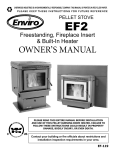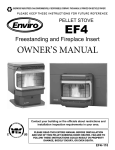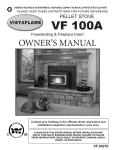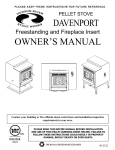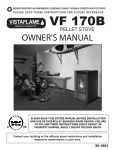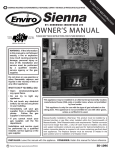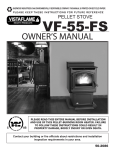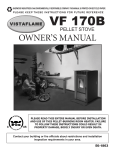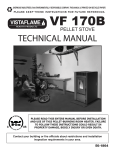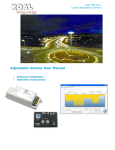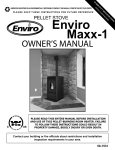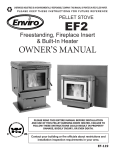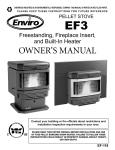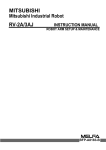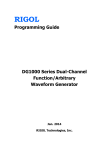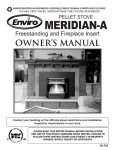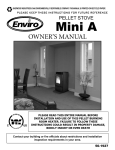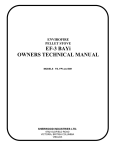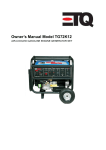Download Vistaflame VF 100A Owner`s manual
Transcript
SHERWOOD INDUSTRIES IS AN ENVIRONMENTALLY RESPONSIBLE COMPANY. THIS MANUAL IS PRINTED ON RECYCLED PAPER. PLEASE KEEP THESE INSTRUCTIONS FOR FUTURE REFERENCE PELLET STOVE VF100-1 Freestanding & Fireplace Insert OWNER’S MANUAL Contact your building or fire officials about restrictions and installation inspection requirements in your area. PLEASE READ THIS ENTIRE MANUAL BEFORE INSTALLATION AND USE OF THIS PELLET BURNING ROOM HEATER. FAILURE TO FOLLOW THESE INSTRUCTIONS COULD RESULT IN PROPERTY DAMAGE, BODILY INJURY, OR EVEN DEATH. VF-50279 Table of Contents Introduction�������������������������������������������������������������������������������������������������������������������������������� 3 Rating Label Location........................................................................................................... 3 Pellet Quality....................................................................................................................... 3 Important Safety Data.......................................................................................................... 4 Safety Warnings And Recommendations................................................................................ 4 Specifications������������������������������������������������������������������������������������������������������������������������������ 6 Dimensions - Freestanding.................................................................................................... 6 Dimensions - Insert.............................................................................................................. 6 Operating Instructions����������������������������������������������������������������������������������������������������������������� 7 Pre-Burn Instructions........................................................................................................... 7 Automatic Safety Features of Your Pellet Stove....................................................................... 7 The Control Panel................................................................................................................. 7 Operating Your Pellet Stove................................................................................................... 8 Turning Your Pellet Stove Off................................................................................................ 8 Adjusting Trim Settings......................................................................................................... 9 Room Air Fan On/Off............................................................................................................ 9 The Slider/Damper..............................................................................................................10 Fine Tuning Your Pellet Stove...............................................................................................10 Routine Cleaning and Maintenance����������������������������������������������������������������������������������������������11 Removing Your Pellet Stove From the Pallet..........................................................................14 Installation Of Pedestal - Insert............................................................................................14 Adjustment Of Pedestal - Freestanding.................................................................................15 Hearth pad requirements - Freestanding...............................................................................15 Deciding Where to Locate your Pellet Appliance.....................................................................16 Thermostat Installation........................................................................................................16 Outside Fresh-Air Connection...............................................................................................17 Exhaust And Fresh Air Intake Locations................................................................................17 Clearances to Combustibles - Freestanding...........................................................................18 Clearances to Alcove - Freestanding.....................................................................................18 Clearances to Combustibles - Insert......................................................................................18 Vent Termination Requirements............................................................................................19 Mobile Home Installation - Freestanding...............................................................................20 Corner Through Wall Installation - Freestanding....................................................................20 Horizontal Exhaust Through Wall Installation - Freestanding...................................................21 Through Wall With Vertical Rise and Horizontal Termination Installation - Freestanding............22 Inside Vertical Installations - Freestanding............................................................................23 Outside Vertical Installations - Freestanding..........................................................................23 Hearth Mount Installation - Freestanding:.............................................................................24 Masonry Fireplace Installation - Fireplace Insert....................................................................25 Installation Into Factory Built Fireplaces................................................................................27 Installation of Control Panel into Surround Panel - Insert.......................................................27 Installation and Removal of The Surround Panels - Insert.......................................................28 Troubleshooting�������������������������������������������������������������������������������������������������������������������������29 Resetting the High Limit Sensor...........................................................................................33 Wiring Diagram��������������������������������������������������������������������������������������������������������������������������34 Parts List�����������������������������������������������������������������������������������������������������������������������������������35 Parts Diagram - Components�������������������������������������������������������������������������������������������������������38 Parts Diagram - Steel������������������������������������������������������������������������������������������������������������������39 Warranty�����������������������������������������������������������������������������������������������������������������������������������40 Installation Data Sheet���������������������������������������������������������������������������������������������������������������41 2 Introduction Rating Label Location Freestanding: The rating label is located on the inside of the hopper lid. Insert: The rating label is located on the hopper cover. Pellet Quality Pellet quality is important, please read the following: Your Vista Flame pellet stove has been designed to burn wood pellets only. Do not use any other type of fuel, as this will void any warranties stated in this manual. The performance of your pellet stove is greatly affected by the type and quality of wood pellets being burned. As the heat output of various quality wood pellets differs, so will the performance and heat output of the pellet stove. CAUTION: It is important to select and use only pellets that are dry and free of dirt or any impurities such as high salt content. Dirty fuel will adversely affect the operation and performance of the unit and will void the warranty. The Pellet Fuel Industries (P.F.I.) has established standards for wood pellet manufacturers. We recommend the use of pellets that meet or exceed these standards. Ask your dealer for a recommended pellet type. PELLET FUEL INSTITUTE STANDARDS: Fines (fine particles)......1% maximum through a ⅛” screen Bulk Density..................40 pound per cubic foot minimum Size..............................¼” to 5/16” diameter ½ – 1½” long maximum Ash Content..................1% maximum (Premium grade) ..................3% maximum (Standard grade) Moisture Content...........8% maximum Heat Content.................Approximately 8200 BTU per pound minimum ASH: The ash content of the fuel and operation of your stove will directly determine the frequency of cleaning. The use of high ash fuels may result in the stove needing to be cleaned daily. A low ash fuel may allow longer intervals between cleaning. CLINKERING: [clinkers are silica (sand) or other impurities in the fuel that will form a hard mass during the burning process]. This hard mass will block the air flow through the Burn Pot Liner and affect the performance of the stove. Any fuel, even approved types, may tend to clinker. Check the Burn-Pot Liner daily to ensure that the holes are not blocked with clinkers. If they become blocked, remove the liner (when the unit is cold) and clean/scrape the clinkers out. Clean the holes with a small pointed object if required. Refer to the section Routine Cleaning and Maintenance. PELLET FEED RATES: Due to different fuel densities and sizes, pellet feed rates may vary. This may require an adjustment to the slider damper setting or to the auger feed trim setting on low. Since Sherwood Industries Ltd. has no control over the quality of pellets that you use, we assume no liability for your choice in wood pellets. Store pellets at least 36” (1 m) away from the pellet stove. 3 Introduction Important Safety Data Please read this entire Owner’s Manual before installing or operating your VistaFlame Pellet Stove. Failure to follow these instructions may result in property damage, bodily injury or even death. Contact your local building or fire official to obtain a permit and any information on installation restrictions and inspection requirements for your area. To prevent the possibility of a fire, ensure that the appliance is properly installed by adhering to the installation instructions. A VistaFlame dealer will be happy to assist you in obtaining information with regards to your local building codes and installation restrictions. Be sure to maintain the structural integrity of the home when passing a vent through walls, ceilings, or roofs. The stove’s exhaust system works with negative combustion chamber pressure and a slightly positive chimney pressure. It is very important to ensure that the exhaust system is sealed and airtight. The ash pan and viewing door must be locked securely for proper and safe operation of the pellet stove. Do not burn with insufficient combustion air. A periodic check is recommended to ensure proper combustion air is admitted to the combustion chamber. Setting the proper combustion air is achieved by adjusting the slider damper located on the left side of the stove. When installing the stove in a mobile home, it must be electrically grounded to the steel chassis of the home and bolted to the floor. Make sure that the structural integrity of the home is maintained and all construction meets local building codes. Minor soot or creosote may accumulate when the stove is operated under incorrect conditions such as an extremely rich burn (black tipped, lazy orange flames). Safety Warnings And Recommendations Caution: Do not connect to any air distribution duct or system. Do not burn garbage or flammable fluids such as gasoline, naptha or engine oil. Unit hot while in operation. Keep children, clothing and furniture away. Contact may cause skin burns. FUEL: This pellet stove is designed and approved to only burn wood pellet fuel with up to 3% ash content. Dirty fuel will adversely affect the operation and performance of the unit and may void the warranty. Check with your dealer for fuel recommendations. THE USE OF CORDWOOD IS PROHIBITED BY LAW. SOOT: Operation of the stove with insufficient combustion air will result in the formation of soot which will collect on the glass, the heat exchanger, the exhaust vent system, and may stain the outside of the house. This is a dangerous situation and is inefficient. Frequently check your stove and adjust the slider/ damper as needed to ensure proper combustion. See: “Slider/Damper Setting”. CLEANING: There will be some build up of fly ash and small amounts of creosote in the exhaust. This will vary due to the ash content of the fuel used and the operation of the stove. It is advisable to inspect and clean the exhaust vent semi-annually or every two tons of pellets. ASHES: Disposed ashes should be placed in a metal container with a tight fitting lid. The closed container of ashes should be on a non-combustible floor on the ground, well away from all combustible materials pending final disposal. If the ashes are disposed of by burial in soil or otherwise locally dispensed, they should be retained in the closed container until all cinders have been thoroughly cooled. 4 Introduction ELECTRICAL: The use of a surge protected power bar is recommended. The unit must be grounded. The grounded electrical cord should be connected to a standard 115 volts (4.5 Amps), 60 hertz electrical outlet. Ensure that the polarity to the outlet that the unit will be plugged into is correct; as incorrect polarity can adversely affect the unit’s operation. Be careful that the electrical cord is not trapped under the appliance and that it is clear of any hot surfaces or sharp edges. The power cord must always be accessible. If this power cord should become damaged, a replacement power cord must be purchased from the manufacture or a qualified VistaFlame dealer. The VF100’s maximum power requirement is 520 watts. GLASS: Do not abuse the glass by striking or slamming the door. Do not attempt to operate the stove with broken glass. The stove uses ceramic glass. Replacement glass must be purchased from a VistaFlame dealer. Do not attempt to open the door and clean the glass while the unit is in operation or if glass is hot. To clean the glass, use a soft cotton cloth and mild window cleaner, gas or wood stove glass cleaner, or take a damp paper towel and dip into the fly ash. This is a very mild abrasive and will not damage the glass. FLAMMABLE LIQUIDS: Never use gasoline, gasoline-type lantern fuel, kerosene, charcoal lighter fluid, or similar liquids to start or “freshen up” a fire in the heater. Keep all such liquids well away from the heater while it is in use. SMOKE DETECTOR: Smoke detectors should be installed and maintained in the structure when installing and operating a pellet burning appliance. OPERATION: The ash pan and door must be closed securely for proper and safe operation of the pellet stove. Ensure all gaskets on the door are checked regularly and replaced when necessary. KEEP ASH PAN FREE OF RAW FUEL. DO NOT PLACE UNBURNED OR NEW PELLET FUEL IN ASH PAN. A fire in the ash pan may occur. INSTALLATION: Be sure to maintain the structural integrity of your home when passing a vent through walls, ceilings, or roofs. It is recommended that the unit be secured into its position in order to avoid any displacement. DO NOT INSTALL A FLUE DAMPER IN THE EXHAUST VENTING SYSTEM OF THIS UNIT. DO NOT CONNECT THIS UNIT TO A CHIMNEY FLUE SERVING ANOTHER APPLIANCE. FRESH AIR: Outside Fresh Air connection is optional, but must be connected to all units installed in Mobile and “Air Tight Homes” (R2000) or where required by local codes. Consider all large air moving devices when installing your unit and provide room air accordingly. Limited air for combustion may result in poor performance, smoking, and other side effects of poor combustion. If you have any questions with regards to your stove or the above-mentioned information, please feel free to contact your local dealer for further clarification and comments. SINCE SHERWOOD INDUSTRIES LTD. HAS NO CONTROL OVER THE INSTALLATION OF YOUR STOVE, SHERWOOD INDUSTRIES LTD. GRANTS NO WARRANTY IMPLIED OR STATED FOR THE INSTALLATION OR MAINTENANCE OF YOUR STOVE. THEREFORE, SHERWOOD INDUSTRIES LTD. ASSUMES NO RESPONSIBILITY FOR ANY CONSEQUENTIAL DAMAGE(S). SAVE THIS INSTRUCTION MANUAL FOR FUTURE REFERENCE 5 Specifications Dimensions - Freestanding 22" 559 34" 867 1 26 4 " 667 1 24 2 " 620 Figure 1: Dimensions of VF100 Freestanding. Dimensions - Insert 3 23 4 " 602 OS PANEL 46" [1158] REG PANEL 40" [1016] 3 12 4 " 322 22" 559 OS PANEL 32 7/8" [835] REG PANEL 30 1/8" [766] 1 1 4 " 35 Figure 2: Dimensions of VF100 Insert. 6 23" 582 Operating Instructions Pre-Burn Instructions The burn pot liner holes must be clear and the liner installed properly against the ignitor tube for proper operation. Check the hopper for enough pellets to start the unit. If this is the first time the unit has been started or the unit has run out of fuel, the auger will need to be primed. This can be done by restarting the unit five (5) minutes into its start-up or by putting a small hand full of pellets into the burnpot. NEVER OPERATE THE UNIT WITH THE DOOR OR ASH PAN OPEN. Automatic Safety Features of Your Pellet Stove A. EXHAUST TEMPERATURE SWITCH: The stove will shut off automatically if the exhaust temperature drops below 49°C (120°F). B. HIGH LIMIT SAFETY SWITCH: If the temperature on the hopper reaches 93°C (200°F), the auger will automatically stop and the stove will shut down when the exhaust temperature cools. If this happens, call your local dealer to reset the 93°C (200°F) high limit switch. IT IS IMPORTANT TO DETERMINE THE REASON THAT THE UNIT OVERHEATED. C. VACUUM SWITCH: If the combustion fan fails or the exhaust vent becomes blocked this switch will stop the auger feed motor and the fire will go out. The Control Panel 1. AUGER LIGHT: This green light will flash when the auger pulses. 2. MODE LIGHT: This light will signal the current state of the unit. If the light is flashing the unit is in automatic start mode or the thermostat has control of the unit. Heat settings cannot be changed. If the light is solid, the heat level settings can be changed. 3. THERMOSTAT SWITCH: Sets the unit to one of the two thermostat modes (High/Low or Auto/Off) or manual operation mode. 4. FEED RATE TRIM BUTTON: Fine tuning control for adjusting the feed. See “Adjusting Trim Settings.” 5. COMBUSTION BLOWER TRIM BUTTON: Fine tuning control for adjusting the combustion air flow. See “Adjusting Trim Settings.” 7. ROOM AIR FAN ON/OFF BUTTON: Used to turn convection fan on or off. See “Room Air Fan On/Off.” 8. HEAT LEVEL ADJUSTMENT BUTTONS: When pressed, will change the heat level setting of the unit up or down. 9. HEAT OUTPUT INDICATOR: Shows the current heat output setting. 9 AUGER 1 MODE 2 AUTO/OFF 3 HIGH/LOW MANUAL 4 8 HEAT LEVEL FEED RATE TRIM 5 COMBUSTION BLOWER TRIM 6 7 ROOM AIR FAN ON/OFF ON/OFF C-11625 Figure 3: VF100 Control Panel 7 Operating Instructions Operating Your Pellet Stove AUGER 1 MANUAL MODE: MODE 2 To START:9 Press the ON / OFF button. The stove will begin the startup AUTO/OFF cycle. The mode light will be flashing. The Auger Light will flash with HIGH/LOW 3 will show the heat level each pulse of the auger. The heat level indicator MANUAL the unit will operate at after completing the startup cycle. To OPERATE: When a fire has been established, the System Light will 4 turn solid (after approximately 10 - 15 minutes). The room air fan will FEED RATE HEATof LEVEL turn on. The this fan is controlled by the heat level setting. 8 speed 1 AUGER TRIM 5 MODE 2 HIGH/LOW MODE (Requires a thermostat) COMBUSTION 9 BLOWER TRIM To START: Same as ‘Manual AUTO/OFF Mode’ above. HIGH/LOW 36 OPERATION: When operating in High/Low mode the stove will run on 7 MANUAL one of two levels,ROOM depending on whether AIR ON/OFF or not the thermostat is calling for heat. When FAN theON/OFF thermostat is calling for heat the stove will run on 4 is not calling for heat, High setting (adjustable). When the thermostat RATE the stove 8will run on Low settingFEED (#1, not adjustable). To adjust the HEAT LEVEL TRIM High setting press the heat level up/down buttons. The High setting C-11625 5 can be set to heat levels 2 through 5. 1 AUGER COMBUSTION AUGER MODE AUTO/OFF HIGH/LOW MANUAL Figure 4: ThermostatFEED Switch RATEin HEAT LEVEL MANUAL position. AUGER TRIM MODE COMBUSTION BLOWER TRIM AUTO/OFF HIGH/LOW ROOM AIR FAN ON/OFF HEAT LEVEL MANUAL ON/OFF FEED RATE TRIM Figure 5: Thermostat Switch in C-11625 HIGH/LOW position. BLOWER TRIM AUGER COMBUSTION BLOWER TRIM AUTO/OFF MODE: (Requires aMODE thermostat) 2 MODE 6 7 9 To START: The unit will start automatically. AUTO/OFF AUTO/OFF ROOM AIR ON/OFF ROOM AIR ON/OFF OPERATION: FAN The stove will start automatically ON/OFF FAN ON/OFF HIGH/LOW HIGH/LOW 3 when the thermostat calls for heat. Once the startup cycle is complete, the stove will run MANUAL MANUAL at the heat level indicated on the display (adjustable). When the thermostat stops calling for heat, the stove will 4 automatically decrease C-11625 C-11625 the heat level to setting #1 for thirty minutes. If the thermostat calls FEED RATE FEED RATE HEAT LEVEL HEAT LEVEL 8 TRIM TRIM for heat within the thirty minutes, the stove will increase the heat level back to the heat level indicated on the display.5 If the thermostat does Figure 6: Thermostat Switch in ON/ not call for heat within thirty minutes, the stove will begin a shutdown OFF position. COMBUSTION COMBUSTION cycle. The stove will restart the next time BLOWER TRIM the thermostat calls for heat. BLOWER TRIM To adjust the high setting, press the heat level up/down buttons. 6 7 ROOM AIR ON/OFF ROOM AIR ON/OFF Note: TheFAN thermostat mode can be changed at any time during normal operation. ON/OFF FAN ON/OFF Turning Your Pellet Stove Off • MANUAL and HI / LOW mode: To turn the unit OFF, simply press the ON / OFF button. This will stop C-11625 C-11625 the feed of pellets. The fans will continue to operate while the stove cools down. When cool enough, the fans will turn off. • AUTO / OFF mode: To turn the unit OFF, turn the thermostat down or off. NOTE: The unit will run on low for thirty minutes before it begins a shutdown cycle. To force the stove to start a shutdown, switch the mode to MANUAL and press the On/Off button. The stove will begin a shutdown cycle. NEVER unplug the unit while Combustion fan is operating. This may lead to smoke escaping from the stove. 8 Operating Instructions Adjusting Trim Settings The Feed Rate Trim and Combustion Blower Trim are used to fine tune the operation of the unit for varying fuels. Both trim settings will affect the operation in all modes, and across all heat levels. The trim settings can be adjusted in any mode (Manual, High/Low, Auto/Off), but only when the unit is in operation. Trim settings cannot be adjusted while the unit is in a startup or shutdown cycle. Determining the Current Trim Setting: When one of the trim buttons are pressed the control panel will display the current setting for that trim feature. Four of the lights on the heat level display will come on, the light that is off shows the current setting. AUGER MODE Changing a Trim Setting: AUTO/OFF To change a trim setting, hold down the button for the setting you would like to change. The current setting for that trim will be displayed. While holding the trim button, press either the heat level up or heat level down button to adjust the trim in that direction. Feed Rate Trim: HIGH/LOW MANUAL HEAT LEVEL The feed rate trim allows the user to fine tune the fuel feed setting. Trim up to increase the feed setting, trim down to decrease the feed setting. The factory setting for the feed rate trim is #4. FEED RATE TRIM AUGER COMBUSTION BLOWER TRIM Combustion Blower Trim: The combustion blower trim allows the user to fine tune the combustion air flow setting. Trim up to increase the amount of air fed to the fire, trim down to decrease the air. The factory setting for the combustion blower trim is #2. ROOM AIR FAN ON/OFF ON/OFF MODE AUTO/OFF HIGH/LOW MANUAL Figure 7: Trim set to #4 setting. FEE C-11625 NOTE: Some trim settings may cause undesirable operation with some fuels. Refer to “Fine HEAT LEVEL Tuning Your Pellet Stove” for more information. Room Air Fan On/Off COM BLOW The Room Air Fan On/Off control allows the user to reduce the noise level of the unit temporarily by turning the Room Air (heat distribution) fan off. If the unit begins to overheat; the Room Air Fan control will be bypassed automatically and the fan will come on HIGH to cool the unit down. Once ROOM AIR the unit cools the fan will turn off. FAN ON/OFF For best efficiency the Room Air Fan should be left on at all times. Figure 8: Room Air Fan Control. O 9 Operating Instructions The Slider/Damper THE SLIDER/DAMPER MUST BE SET CORRECTLY FOR PROPER OPERATION. IMPROPER SETTING OF THE SLIDER/DAMPER CAN CAUSE POOR COMBUSTION, OVERHEAT CONDITIONS, AND NUISANCE SHUTDOWNS. The slider damper will need to be adjusted regularly depending on varying fuels, the cleanliness of the unit and venting, and other factors. The easiest way to set the slider damper for proper operation is to observe and understand the characteristics of the flame. • A tall, lazy flame with dark orange or black tips requires more air – pull the slider out to increase the air to the fire. • A short, brisk flame, like a blowtorch, has too much air – push the slider in to decrease the air to the fire. • A bright yellow/orange active flame, without black or orange tips has the correct amount of air for proper operation Refer to figure 9. The combustion exhaust blower is a variable speed fan controlled by the heat level setting. The fan will automatically turn down on lower heat settings to adjust the air to fuel ratio. Some adjustment of the slider/damper may still be required depending on your specific venting and fuel. Figure 9: Efficient Flame. SPECIAL NOTES: Pellet quality is a major factor in how the Pellet stove will operate. If the pellets have a high moisture or ash content the fire will be less efficient and is more likely to build up and create clinkers (hard ash build-up) in the burn pot. For best results, select only fuel that complies to the Pellet Fuel Institute Standards (see page 3). Fine Tuning Your Pellet Stove Due to varying fuel quality the slider damper and control board trims may need to be fine-tuned. 1.If the unit builds up on all settings, the slider damper rod should be pulled out in small increments to give the unit more air until the unit stops building up. 2.If the unit has excess ash build-up in the liner on the lower feed settings only, the Combustion Blower Trim should be increased one setting at a time until the problem improves (Factory Setting is #2). 3.If the fire is going out on low (because the airflow is too great), the Combustion Blower Trim can be lowered to the #1 setting. 4.If the stove has excess ash build-up in the liner on the higher settings the Feed Rate Trim should be trimmed down a setting at a time until the problem improves (Factory setting is #4). 5.If you need more heat and the fuel has long pellets, (the majority are over 1” (2.5cm) in length), the Feed Rate Trim can be moved up to the #5 setting. NOTE: Only do this if the fuel burns without building up. 10 Routine Cleaning and Maintenance NOTE: Do not use abrasive cleaners to clean the surface or any part of the stove. The following should be inspected periodically to ensure that the appliance is operating at its optimum and giving you excellent heat value: TOOLS REQUIRED TO CLEAN UNIT • Torx T-20 Screwdriver 2-3 Days / Weekly Biannually or 2 Tons of Fuel • 5/16” Wrench or Socket, Burn Pot and Liner Exhaust Vent • Brush, Ash Pan Fresh air Intake Tube • Soft Cloth Inside Firebox Blower Mechanisms • Vacuum with fine filter bag Door Glass Heat exchanger tubes Heat exchanger tubes Behind firebox liners The following list of components should be Ash pan & Door gaskets All Hinges inspected and maintained routinely to ensure Door Latch Post Season Clean-up that the appliance is operating at its optimum and giving you excellent heat value: BURN POT AND LINER (2-3 days) This is the ‘pot’ where the pellets are burned. The burn pot and liner should be inspected every two to three (2-3) days, to ensure proper air flow through the liner. Failure to keep the liner clean may cause a build up of fuel past the burn pot liner and up the drop tube. This will cause the auger to jam and may result in pellets burning in the drop tube and hopper. Ensure the unit is cold before cleaning. To remove the burn pot and burn pot liner, open the door using the door handle provided, located on the left-hand side of the stove. Swing the door open. Lift the liner from the burn pot. Lift the burn pot from the firebox by gently lifting the front of the burn pot up first, then sliding the assembly from the air intake tube and the ignitor cartridge. Using a metal scraper, remove material that has accumulated or is clogging the liner’s holes. Then dispose of the scrapped ashes from the liner and from inside the burn pot. Place the burn pot back into the stove, making sure that the pipes are properly inserted into the burn pot and the front tabs are placed in the firebox. Place the liner back into the burn-pot making sure that the ignitor hole in the liner is aligned with the ignitor tube. Push the liner up against the ignitor tube. ● If, after long periods of burning, the fire continually builds up and overflows the burn pot or there is a build up of clinkers, this is an indication that the pellet fuel quality is poor or the stove may need cleaning. Check the stove for ash build up (clean if required) and adjust the slider / damper to produce the proper clean combustion. Burn pot liner Ignitor tube Fresh air tube Burn pot Figure 10: Burn pot with liner. INSIDE FIREBOX (weekly) For biweekly clean out, ash may be removed from behind the steel plates by rotating the circular cover to allow vacuuming behind the plates. ASH PAN AND DOOR GASKETS (weekly) After extended use the gasket may come loose. To repair or replace this, glue the gasket on, using hightemperature fiberglass gasket glue. This is important to maintain an airtight assembly. 11 Routine Cleaning and Maintenance ASH PAN (2-3 days) Monitor the ash level every week. Remember that different pellet fuels will have different ash contents. Ash content is a good indication of fuel efficiency and quality. Refer to “Warnings and Recommendations” for disposal of ashes. DO NOT PLACE UNBURNED OR RAW PELLET FUEL IN ASH PAN. Dump the ashes into a metal container stored away from combustibles. Monitor the ash level every week. Remember that different pellet fuels will have different ash contents. Ash content is a good indication of fuel efficiency and quality. Refer to “Warnings and Recommendations” for disposal of ashes. Vacuum the ash pan and inside the pedestal. CAUTION: BECAUSE THE FLY ASH IS VERY FINE, THE USE OF A FINE FILTER VACUUM BAG WILL BE REQUIRED TO PREVENT ASH FROM BEING BLOWN BACK INTO THE ROOM. Please pay special attention that there are no hot ashes in the firebox or there could be a possibility of a fire hazard inside the vacuum cleaner. Place all hot ashes into a non-combustible container. FREESTANDING ASH PAN: The VF100 pellet stove freestanding’s ash pan is located under the burner, in the pedestal, and has a latching mechanism to secure it. To remove the ash pan, unlock the latch on the ash pan and then pull the pan out. INSERT ASH PAN: The VF100 pellet stove insert’s ash pan is located behind the lower grill. HEAT EXCHANGER TUBES (2-3 days) Heat exchange tube cleaner rod The handle for the heat exchanger cleaning rod is pointed out in Figure 9. This handle is to be pulled back and forth a few times (ONLY WHEN THE UNIT IS COLD) in order to clean away any fly ash that may have collected on the heat exchanger tubes. As different types of pellets produce different amounts of ash, cleaning of the tubes should be done on a regular basis to enable the unit to run efficiently. FRESH AIR INTAKE (season) Inspect periodically to be sure that it is not clogged with any foreign materials. EXHAUST PASSAGES (season) Figure 11: VF100 Heat exchanger rod. For biweekly clean out, ash may be removed from behind the steel plates by rotating the circular covers located behind the right and left side panels. Loosen the screw on the disks and open, this will allow vacuuming behind the firebox liner’s plates. Removal of the firebox backing for biannual cleaning: • Remove the top baffle. • Lubricate and then remove the seven (7) screws that hold the brick liner in place. Tilt the top of the brick panel towards the firebox opening and remove from the firebox • Remove the top rod by first removing the screw that holds it in place, then slide the rod sideways • Pull the side panels into the center of the firebox, then out • Pull the center panel out. • Clean and vacuum all passages thoroughly. 12 Routine Cleaning and Maintenance Installation of firebox backing: • Install the side panels in place. Insert center panel, hold the panels in place • Install the top rod by sliding it into one side panel then across into the other panel. Screw rod in place. • Re-install steel brick liner and screw in place. • Replace top baffle EXHAUST VENT (season) The products of combustion will contain small particles of flyash. The flyash will collect in the exhaust venting system and restrict the flow of the flue gases. Incomplete combustion, such as occurs during startup, shutdown, or incorrect operation of the room heater will lead to some soot formation which will collect in the exhaust venting system. The exhaust venting system should be inspected at least once every year or after two tons of pellets to determine if cleaning is necessary. We recommend contacting your dealer for professional cleaning. To remove dust from the vent pipe, tap lightly on the pipe to dislodge any loose ash. Open the bottom of the “T” to dump the ash, then vacuum as much of the ash out of the vent pipe as possible. BLOWER MECHANISMS (season) Unplug the stove then open the right/left side panels to access the two blowers. Vacuum all dust from motors. Only the convection blower motor (on the right side of the stove) will require lubrication. The convection motor has two lubrication holes on it. Use two drops of SAE 20 light oil to lubricate every six months. Excess oil may damage the motor. The exhaust blower’s motor has sealed bearings, DO NOT lubricate this motor. DOOR GLASS (It is recommended that your dealer replace the glass if broken.) The door glass is made of 5 mm thick, high temperature PYROCERAMIC. To replace the glass, unscrew and remove the four glass retainers. Remove the glass and any broken pieces. High temperature fiberglass tape should be used around the glass. Replace the glass, center the glass assembly in the frame, then screw the glass retainers back to the frame. The use of substitute materials is prohibited use only part EF-062. POST SEASON CLEAN-UP Once you are finished using the pellet appliance for the season, unplug the stove for added electrical protection. It is very important that the stove be cleaned and serviced as stated above. CLEANING PLATED SURFACES Please clean all fingerprints off of all gold parts, with denatured alcohol on a soft cloth, before firing the unit each time. Fingerprints, etc. can become permanently etched into the gold if not removed before operating the pellet heater. BRICK PANEL The paint on the steel brick panel may peel. This is due to extreme conditions applied to the paint and is in no way covered by warranty. 13 Installation Removing Your Pellet Stove From the Pallet FREESTANDING: To remove your new freestanding stove from its pallet, remove the ash pan, remove the two metal plugs in the bottom of the pedestal, remove the two (2) wood screws under the plugs. Also remove the two (2) wood screws on the back of the pedestal. Remove the unit from the pallet, replace the two metal plugs, and replace the ash pan. INSERT: To remove your new insert stove from its pallet, remove the two (2) wood screws just inside the unit. Remove the unit form the pallet and install the pedestal. See “Installation Of Pedestal - Insert.” METAL PLUGS WOOD SCREWS 2 SCREWS Figure 12: Removing Freestanding from Pallet. Figure 13: Removing Insert from Pallet. Installation Of Pedestal - Insert The Fireplace Insert model is supplied with a pedestal that must to be attached prior to installation: 1. Remove the unit from the pedestal. 2.Remove the pedestal from the hopper. 3.Place the unit on its back on the pallet. 4.Remove the 4 5/16” hex head screws from the bottom of the unit. 5.Secure the pedestal to the unit using the four screws removed in step 4. See figure 14. Figure 14: Installing pedestal onto unit. 14 Adjustment Of Pedestal - Freestanding The freestanding model is supplied with a pedestal already attached to the fireplace. Once your free standing stove has been removed form the pallet you can adjust the pedestal base. There are three positions for the pedestal base. The position are 2.25, 3.50, and 6.00 inches from the inside of the door opening to the front edge of the pedestal base, the stove is packaged in the 2.25 inch position. 2.25” 3.50” 6.00” 1. Remove the fireplace from the pedestal. This is done by removing the ash drawer and loosening the four 5/16” hex head screws located inside the pedestal. 2.Once loose the stove can slid backward and lifted off the pedestal. 3. Flip the pedestal over and remove the four 5/16” hex head screws which secure the pedestal base. 4. Move pedestal base to desired position and secure using the same screws. Figure 15: Pedestal adjustments. Hearth pad requirements - Freestanding When installing this unit on carpet a non-combustible hearth pad is always required, it does not matter what position the pedestal base is in. A non-combustible hearth pad is also required on solid combustible materials (hardwood, linoleum) in the 2.25 and 3.50 inch positions. If the pedestal base has been adjusted to the furthest forward position (6.00 inch) no heath pad is required. In the 6 inch position the pedestal base provides sufficient floor protection to be installed on solid combustible material without a hearth pad. Hardwood Figure 16: Pedestal 6” position no hearth pad Carpet Figure 17: Pedestal 6” position no heath pad Hardwood Figure 18: Pedestal 2.25” position with hearth pad 15 Installation Deciding Where to Locate your Pellet Appliance 1. Do not install the stove in a bedroom or room where people sleep in. 2. Locate the stove in a large and open room that is centrally located in the house. This will optimize heat circulation. 3. Check clearances to combustibles and for the least amount of interference to house framing, plumbing, wiring, etc. 4. You can vent the stove with approved pipe through an exterior wall behind the unit or pass it through the ceiling and roof. The stove can connect to an existing masonry or metal chimney (must be lined if the chimney is over 6” (15 cm) diameter, or over 28 inches² (180 cm²) cross sectional area). 5. This unit must not be installed directly onto carpet. If it is to be installed on a carpeted area a non-combustible hearth pad must be installed between the unit and the carpet. 6. If the unit is to be installed on a solid combustible surface (hardwood, linoleum) a non-combustible hard pad is required unless the pedestal has been adjusted as seen in page 16. 7. This unit uses large quantities of air for combustion; outside Fresh Air connection is strongly recommended. Fresh Air must be connected where required by local codes. 8. Do not obtain combustion air from an attic, garage or any unventilated space. Combustion air may be obtained from a ventilated crawlspace. 9. The power cord is 8 feet (2.43 m) long and may require a grounded extension cord to reach the nearest electrical outlet. Thermostat Installation 1. Install the wall thermostat (millivolt rated) in a location that is not to close too the unit but will effectively heat the desired area. 2. Connect the Thermostat or Timer using a 2 x 18 gauge wire from the unit to the thermostat. Remove jumper wire and install thermostat wires here. Figure 19: Thermostat wire placement. 16 If the heat in the room becomes to great, the high limit switch may turn the stove off and the switch will have to be manually reset. To reset the high limit switch, remove the right cabinet side. The switch is found on the air jacket. Installation Outside Fresh-Air Connection Outside fresh air is mandatory when installing this unit in airtight homes and mobile homes. When connecting to an outside fresh air source, do not use plastic or combustible pipe. A 1⅝” minimum (42 mm) ID (inside diameter) steel, aluminum or copper pipe should be used. Keep the length of the fresh air intake pipe as short as possible, with as few bends as possible. Outside Wall 1 5/8" ID (42 mm) Optional Elbow Figure 20: Outside Air Connection. Exhaust And Fresh Air Intake Locations Base of unit to center of flue Side of unit to center of flue Center of unit to center of flue Base of unit to center of intake Side of unit to center of intake Center of unit to center of intake Freestanding 20 ¼” (515 mm) 5 3/16” (132 mm) 5 ¾” (146 mm) 14 ⅝” (372 mm) 12” (304 mm) 1” (25 mm) Fireplace Insert 9” (228 mm) 5 3/16” (132 mm) 5 ¾” (146 mm) 3 ⅜” (74 mm) 12” (304 mm) 1” (25 mm) INSTALL VENT AT CLEARANCES SPECIFIED BY THE VENTING MANUFACTURER 1" (25 mm) 5 3/4" (146 mm) 1" (25 mm) 5 3/4" (146 mm) 20 1/4" (515 mm) 14 5/8" (372 mm) 9" (228 mm) 3 3/8" (86 mm) 12" (304 mm) 5 3/16" (132 mm) Figure 21: VF100 Freestanding Inlet and Outlet Location. 12" (304 mm) 5 3/16" (132 mm) Figure 22: VF100 Fireplace Insert Inlet and Outlet Location. 17 Installation Clearances to Combustibles - Freestanding Back Wall Ad jac 1" When installing this unit on a combustible floor (for example linoleum, hardwood flooring) a non-combustible hearth pad must be under the unit, unless installed as shown on page 16. The pad must extend at least the width of the appliance [22” (558 mm)] and at least the depth of the appliance plus 6” (153 mm) in front of the appliance [30½” (775 mm)]. A non-combustible hearth pad must always be used if installing on carpet en 1" tW all 6" 6" Floor Figure 23: VF100 FS Clearance to Combustibles. Side wall to unit - 6 inches (15 cm) Back wall to unit - 1 inches (2.5 cm) Corner to unit - 1 inches (2.5 cm) Door front to edge of floor protection - 6 inches (15 cm) NOTE: These dimensions are minimum clearances but it is recommended that you ensure sufficient room for servicing, routine cleaning and maintenance. Clearances to Alcove - Freestanding 36" (91cm) 30" (76cm) Minimum Alcove width Minimum Alcove height Maximum Alcove depth - 36 inches - 48 inches - 30 inches (91 cm) (122 cm) (76 cm) 48" (122cm) Figure 24: VF100 FS Alcove Size. Clearances to Combustibles - Insert 10" Refer to Figure 15. - 8 inches (20.3 cm) Mantel projection - 10 inches (25.4 cm) Mantel to top of unit - 8 inches (20.3 cm) Top facing to unit - 8 inches (20.3 cm) Side facing to unit - 6 inches (15.2 cm) Floor protection - 6 inches (15.2 cm) On either side and to the front must be protected by non-combustible material. Min. 8" (203mm) Min. 8" (203mm) Side Wall Side wall to unit 6" (152mm ) Figure 25: VF100 FPI Clearance to Combustibles. 18 Installation Vent Termination Requirements IT IS RECOMMENDED THAT YOUR PELLET STOVE BE INSTALLED BY AN AUTHORIZED DEALER/INSTALLER. Table 1: Use in conjunction with Figure 19 for allowable exterior vent termination locations. Letter Minimum Clearance A 24 in (61 cm) B 48 in (122 cm) Beside/below any door or window that may be opened. (18” (46 cm) if outside fresh air installed.) C 12 in (30 cm) Above any door or window that may be opened. (9” (23 cm) if outside fresh air installed.) D 24 in (61 cm) To any adjacent building, fences and protruding parts of the structure. E 24 in (61 cm) Below any eave or roof overhang F 12 in (30 cm) To outside corner. G 12 in (30 cm) To inside corner, combustible wall (vertical and horizontal terminations). H 3 ft (91 cm) within a height of 15 ft (4.5 m) above the meter/regulator assembly I 3 ft (91 cm) J 12 in (30 cm) Clearance to non-mechanical air supply inlet to building, or the combustion air inlet to any appliance. K 24 in (61 cm) Clearance above roof line for vertical terminations. L 7 ft (2.13 m) Clearance above paved sidewalk or paved driveway located on public property. 1. Do not terminate the vent in any enclosed or semi-enclosed areas such as a carport, garage, attic, crawlspace, narrow walkway, closely fenced area, under a sun deck or porch, or any location that can build up a concentration of fumes such as stairwells, covered breezeway, etc. Description Above grass, top of plants, wood, or any other combustible materials. To each side of center line extended above natural gas or propane meter/ regulator assembly or mechanical vent. From any forced air intake of other appliance G K E D F B Opens G Opens B A Termination Cap Air Supply Inlet G C I G Gas Meter Opens Restriction Zone L H (Termination not allowed) Figure 26: Use in conjunction with Table 1 for allowable exterior vent termination locations. 2. Vent surfaces can become hot enough to cause burns if touched by children. Non-combustible shielding or guards may be required. 3. Termination must exhaust above the inlet elevation. It is recommended that at least five feet of vertical pipe be installed outside when the appliance is vented directly through a wall, to create some natural draft to prevent the possibility of smoke or odor during appliance shut down or power failure. This will keep exhaust from causing a nuisance or hazard from exposing people or shrubs to high temperatures. In any case, the safest and preferred venting method is to extend the vent through the roof vertically. 4. Distance from the bottom of the termination and grade is 12” (30 cm) minimum. This is conditional upon the plants and nature of grade surface. The exhaust gases are hot enough to ignite grass, plants and shrubs located in the vicinity of termination. The grade surface must not be lawn. 5. If the unit is incorrectly vented or the air to fuel mixture is out of balance, a slight discoloration of the exterior of the house might occur. Since these factors are beyond the control of Sherwood Industries Ltd, we grant no guarantee against such incidents. NOTE: Venting terminals shall not be recessed into walls or siding. 19 Installation Mobile Home Installation - Freestanding ● Secure the heater to the floor using the two holes in the pedestal. ● Replace the two metal covers after securing the unit to the floor. ● Ensure the unit is electrically grounded to the chassis of your home (permanently). ● Do not install in a room people sleep in. ● Outside fresh air is mandatory. Secure outside air connections directly to fresh air intake pipe and secure with three (3) screws evenly spaced. VF100 HEARTH PAD FLOORING STEEL FRAME 1/4” LAG BOLTS SECURELY FASTENED GROUND WIRE DIRECTLY TO METAL CHASSIS Figure 27: Mobile home installation. CAUTION: THE STRUCTURAL INTEGRITY OF THE MANUFACTURED HOME FLOOR, WALL AND CEILING/ROOF MUST BE MAINTAINED. Corner Through Wall Installation - Freestanding Fresh Air Intake 2" (5 cm) Wall thimble manufactured by pellet vent manufacturer. 2" (5 cm) 6" (15 cm) Floor Protection Figure 28: Corner Installation. 20 Installation Horizontal Exhaust Through Wall Installation - Freestanding Vent installation: install vent at clearances specified by the vent manufacturer. A chimney connector shall not pass through an attic or roof space, closet or similar concealed spaces, or a floor, or ceiling. Where passage through a wall or partition of combustible construction is desired, the installation shall conform to CAN/CSA-B365 Installation Code for Solid-Fuel-Burning Appliances and Equipment. Only use venting of L or PL type with an inside diameter of 3 or 4 inches (7.6 or 10.1 cm). 1. Choose a location for your stove that meets the requirements stated in this manual and allows installation with the least amount of interference to house framing, plumbing, wiring, etc. 2. Install a non-combustible hearth pad (where Wall necessary). thimble 2" 3. Place the appliance 15” (37.5 cm) away from (5 cm) the wall. If the stove is to be set on a hearth 12" (30.5 cm) pad, set the unit on it. 4. Locate the center of the exhaust pipe on the stove. Extend that line to the wall. Once you have located the center point on the wall, refer to pellet vent manufacturer installation instructions for correct hole size 6" 45° and clearance to combustibles. (15 cm) elbow 5. Install the wall thimble as per the instructions Fresh air written on the thimble. Maintain an effective intake vapor barrier in accordance with local building codes. 6. Install a length of 3” (76 mm) or 4” (101 Existing floor Non-combustible mm) vent pipe into the wall thimble. The (combustible) floor protection. pipe should install easily into the thimble. 7. Install the fresh air intake (see Outside Fresh Figure 29: Straight through wall Installation. Air Connection). 8. Connect the exhaust vent pipe to the exhaust pipe on the stove. Seal Exhaust Tube the connection with high temperature 3" (75mm) or 4" (100mm) "PL" or "L" vent silicone. Wall Thimble 9. Push the stove straight back, leaving a minimum of 2” (5 cm) 45° Elbow with screen or clearance from the Termination Cap back of the stove to the wall. Seal the vent pipe to the thimble with Fresh Air Intake High Temperature RTV high temperature Silicone Required silicone. Figure 30: Venting to use with straight through wall Installation. 21 Installation 10. The pipe must extend at least 12” (30 cm) away from the building. If necessary, bring another length of pipe (PL type) to the outside of the home to connect to the first section. Do not forget to place high temperature silicone around the pipe that passes through the thimble. 11. Install a vertical pipe, or if all requirements for direct venting are met, install vent termination. The stainless steel cap termination manufactured by the vent manufacturer is recommended. However, when the vent terminates several feet above ground level and there are no trees, plants, etc. within several feet, a 45° elbow can be used as termination. The elbow must be turned down to prevent rain from entering. NOTE: • It is recommended that horizontal through wall installations have 3 to 5 feet (91 to 152 cm) of vertical pipe in the system to help naturally draft the unit in the event of extreme weather or a power outage. • Some horizontal through wall installations may require a “T” and 3 to 5 feet (91 to 152 cm) of vertical pipe outside the building to help draft the unit. This may be required if a proper burn cannot be maintained, after the stove has been tested and the airflow set. This is due to the back pressure in the exhaust caused by airflow around the structure. • Follow vent manufacturer guidelines for installation of venting. High temp Sealant must be used when connecting vent pipe to the unit’s starter pipe. Improper seals at the vent joints may cause combustion by-products to leak into the room where installed - seal as required. Through Wall With Vertical Rise and Horizontal Termination Installation - Freestanding A 45° elbow may be used in place of the termination cap (or stainless steel termination hood). Figure 24 is the recommended installation set up. Figure 25 is the installation to use if there is a concrete or retaining wall in line with exhaust vent on a pellet stove. The termination must be 12” (30 cm) from the outside wall and 12” (30 cm) above the ground. Termination cap Horizontal frame for thimble 90° elbow Termination cap Wall thimble 90° elbow Wall framing Wall framing Vertical section of vent pipe Wall strap Horizontal frame for thimble Vertical section of vent pipe Concrete Wall Clean out tee Wall thimble Figure 31: Venting horizontally with rise. 22 Clean out tee Figure 32: Venting with concrete wall behind unit . Installation Inside Vertical Installations - Freestanding 1. Choose a stove location that is ideal. See the section “Deciding Where 2. Place a non-combustible hearth pad where necessary. 3. Place the unit on the hearth pad (if installed on a carpeted surface) and space the unit in a manner so when the pellet vent is installed vertically, it will be 3” (7.6 cm) away from a combustible wall. 4. Locate the center of the fresh air intake pipe on the unit. Match that center with the same point on the wall and cut a hole about 1 ⅝” (41 mm) in diameter. to Locate your Pellet Appliance.” Rain cap Flashing 24" (61 cm) 3" (7.5 cm) clearance Use wall thimble or ceiling firestop 3" (7.5 cm) 5. Install the fresh air intake pipe. 6. Install the tee with clean out. 7. Install the pellet vent upward from there. When you reach the ceiling, make sure that the vent goes through the ceiling fire stop. Maintain a 3” (7.6 cm) distance to combustibles and keep attic insulation away from the vent pipe. Maintain an effective vapor barrier. 8. Finally, extend the pellet vent to go through the roof flashing. 9. Ensure that the rain cap is approximately 36” (900 mm) above the roof. Tee with cleanout 6" (15 cm) 6" (15 cm) Fresh air intake Non-combustible floor protection. Existing floor (combustible) Figure 33: Inside Vertical Installation. Outside Vertical Installations - Freestanding To accomplish a outside vertical pipe installation, follow steps 1 through 5 in the “Inside Vertical Installations - Freestanding” section and then finish it by performing the following (refer to Figure 27). 1. Install a tee with clean out on the outside of the house. 2. Install PL vent upward from the tee. Make sure that you install support brackets to keep the vent straight and secure. 3. Install ceiling thimble and secure the flashing as you go through the roof. 4. Ensure that the rain cap is approximately 36” (91.5 cm) above the roof. 23 Installation Rain cap Flashing 24" (61 cm) 3" (7.5 cm) Clearance 2" (5 cm) Support bracket Tee with cleanout 6" (15 cm) Type "L" vent Fresh air intake Non-combustible floor protection. Existing floor (combustible) Figure 34: Outside Vertical Installation. Hearth Mount Installation - Freestanding: Rain Cap Fresh-air intake Steel Plate or Flashing Flexible or Rigid 6" Stainless Steel Liner Damper Removed or Fastened Open 10" (25.4 cm) Mantel Minimum 8" (20 cm) from top of stove Clean-out tee Fresh-air intake should come from chimney. If holes already exist, fresh-air intake can be taken through back of fireplace or through ash dump. Min 6" (150 mm) Floor Protection Masonry Fireplace Combustible Floor Figure 35: Freestanding hearth mount installation. 24 Refer to Figures 28 and 29. 1.Install the hearth pad. 2.Lock fireplace damper in the open position. 3.Install a positive flue connector at the fireplace dampers. 4.Connect a tee or a 90° elbow to the exhaust pipe. 5.Install flexible stainless steel liner or listed pellet vent to the top of the chimney. Installation Rain cap Storm collar Seal plate (cover plate) Existing masonry flue Vent pipe (single wall stainless flex pipe or solid PL vent) Flexible vent connector (use this 5 foot [152cm] section of pipe to vent past fireplace damper or small shelf) Fireplace damper location Clean out tee Existing fireplace Figure 36: Freestanding hearth mount installation overview. Masonry Fireplace Installation - Fireplace Insert The fireplace insert model requires a surround panel and a pedestal. When installing this unit, ensure that the pedestal is removed from the inside of the hopper and installed on the bottom of the unit (see “Pedestal Installation”). Assemble surround panel (see “Assembling The Surround Panel - Fireplace Insert”) before starting installation. A non-combustible hearth pad must cover combustible flooring underneath, as well as 6” (150 mm) in front of the heater and 6” (150 mm) to the side of the heater. 1. Install the hearth pad. 2.Lock the fireplace damper in the open position. 3.Install a positive flue connector at the fireplace damper. 25 Installation Rain Cap Fresh-air intake Steel Plate or Flashing Flexible or Rigid 6" Stainless Steel Liner Damper Removed or Fastened Open Flexible stainless steel pipe connection Mantel Minimum 8" (20 cm) from top of stove Surround Panel 4.Connect a tee or 90° degree elbow to the exhaust pipe. 5.This fireplace insert must be installed with a continuous chimney liner of 3” or 4” diameter extending from the fireplace insert to the top of the chimney. The liner must conform to type 3 requirements of CAN/ ULC S635. 6.(Recommended) Install fresh air intake either through the back of the fireplace or through the positive flue connector. Clean-out tee If holes already exist fresh-air intake can be taken through back of fireplace or through the ash dump Min 6" (150 mm) Floor Protection Masonry Fireplace Combustible Floor Figure 37: Masonry fireplace installation. WARNING: When installing the insert into a masonry fireplace, DO NOT remove any bricks or masonry, with the following exception: masonry or steel, including the damper plate, may be removed from the smoke shelf and adjacent damper frame, if necessary, to accommodate a chimney liner. Do this only if their removal will not weaken the structure of the fireplace and chimney, and will not reduce protection for combustible materials to less than that required by the national building code. 26 Installation Installation Into Factory Built Fireplaces When installing the fireplace insert into a zero clearance fireplace, DO NOT cut or modify any factory firebox parts. If the fireplace insert does not fit into a zero clearance fireplace, we recommend you use a freestanding model and install as a hearth mounted unit. Install a 3” (76 mm) flex pipe from the stove to the top of the chimney (see “Hearth Mount Installation - Freestanding:”). 1. This insert must be tested and meet requirements of UL 1482 ULC S629 when tested in a masonry fireplace built per ULC S628 2. The factory built fireplace must be listed per UL 127 or ULC S610 3. Installation must include a full height listed chimney liner meeting type HT requirements. This liner must be securely attached to the insert flue collar and the chimney top. 4. Means must be provided to prevent room air passage to the chimney cavity of the fireplace. This may be accomplished by sealing the damper area around the chimney liner or sealing the fireplace front. 5. The air flow within and around the fireplace shall not be altered by the installation of the insert (no louvers or cooling air or outlet ports blocked) unless specifically tested as such for each factory built fireplace manufacture and model line. (NOTE: using a louver faceplate complies with the requirement). 6. Alteration of the fireplace in any manner is not permitted with the following exceptions: external trim pieces which do not effect the operation of the fireplace may be removed providing they can be stored on or with the fireplace for re assembly if the insert is removed. The chimney damper may be removed to install the chimney liner. 7. Circulating chambers may not be blocked. 8. Means must be provided for removal of the insert to clean the chimney flue. 9. Insert that projects in front of the fireplace must be supplied with appropriate supporting means A permanent metal warning label must be attached to the back of the fireplace stating that the fireplace must be restored to its original condition for safe use with out the insert. Installation of Control Panel into Surround Panel - Insert When installing the control panel into the surround panel, the surround does not need to be assembled. The control board will be found in behind the firebox. Place the control panel on the backside of the right surround panel so the hinge is on the outside and the top and bottom holes on the control panel line up with those on the surround. Attach using two (2) T-20 screws through the front of the surround into the circuit board control panel. After the surround has been assembled and is ready to be installed on the unit, plug the wiring harness into the control panel (see Figure 32). Figure 38: Control Panel Cover. Plug Figure 39: Control Panel Back. 27 Installation Installation and Removal of The Surround Panels - Insert 1. Attach one side trim to the top trim, using a corner bracket (see Figure 33) to secure pieces together. There are two (2) main pieces to each corner bracket (see Figure 34). When installing the corner pieces into the trim, the “B FACE” sides must face each other and the screw heads are to face out. With the bracket in place and the top and a side trim snug together, use a flat head screwdriver to turn the two (2) screws in the bracket to tighten it into the trim. 2. Attach the other side trim piece to the top trim, using the same method used in Step 1. 3.Using three (3) T-20 screws on each side attach the hinges on the side surround panels to the unit’s side panels (refer to Figure 35). 4.Plug the wiring harness into the control panel (see Figure 31). Surround Panel Figure 40: Corner brackets for trim. Figure 41: Two pieces of corner bracket. 5.Loosen the front hopper lid screws and center the top surround panel under the hopper lid., tighten screws. 6.Insert each side panel anchor bolt through the top panel into the corresponding side panel holes and tighten using a 7/16” wench or socket (refer to Figure 36). 7.Place assembled trim over the surround assembly. REMOVAL: When maintenance is required on the unit the surround must be removed. Follow steps 4 through 7 in reverse order. The side panel can remain attached because they swing forward for easy access (refer to Figure 37). Figure 42: Panel placed on unit. Side surrounds swing out Figure 43: Assembling the Surround Panel, back view. 28 Figure 44: Side surround panel swings forward. Troubleshooting Observed Problem A. The stove will not turn on. B. The stove shuts down unexpectedly or does not run and the #2 error light is flashing. Possible Cause Remedy 1. The unit does not have power. 2. The unit is in On/Off thermostat mode and the thermostat is not calling for heat. 3. The fuse has blown. 1. Ensure that the unit is plugged in and that the unit is not plugged into a switched outlet. 2. Turn the thermostat up to call for heat or switch the unit to Manual operation mode Control Panel Symptom: 1. Slider damper is closed down too far to allow for sufficient vacuum. 2. Blocked exhaust or venting system. The #2 light will be flashing if there is insufficient vacuum for proper operation. 3. Sever negative pressure in the area where the unit is installed. 4. Check the fuse on the circuit board. If it has blown, replace the fuse. If the fuse blows again see “The fuse has blown” 1. Pull the slider damper out to increase the flow of air through the firebox. 2. Check the exhaust system and venting for blockage. Clean as necessary. See “Routine Cleaning and Maintenance” 3. Check operation by opening a window on the same side of the house. Does this solve the problem? If so, install fresh air to the unit. See “Installation of Fresh Air.” 5. Blocked hose connection in the exhaust channel. The venting system may require a vertical section to move the vent termination into a lower pressure zone. 4. Check vacuum hose for pinch points or damage. Make sure that hose is not blocked up. Replace or reroute as required. 5. Check hose barb in the exhaust channel for blockage and clean out if necessary. 6. Damage to vacuum switch wiring. 6. Inspect the gray wires. If there is any damage, replace the wiring harness. 7. Combustion fan failure. 7. Visual check- is the combustion fan running? If not, use a multi meter to ensure the fan is getting power. If it is, the combustion fan may need to be replaced. If not, the circuit board may need to be replaced. 8. If the above steps fail to solve the problem, the vacuum switch may need to be replaced. 4. Pinch, break, or blockage in the vacuum hose. 8. Vacuum switch failure. 29 Troubleshooting Observed Problem C. The stove shuts down unexpectedly and the #3 error light is flashing. Control Panel Symptom: The #3 light will be flashing if the unit shuts down due to lack of fuel or fire. Possible Cause 1. The unit has run out of fuel. 2. The auger is jammed or is not feeding. 3. Unit failed to produce enough heat during the startup cycle. 4. Too much primary air- the feed rate is insufficient to keep up with the burn rate. 5. Poor quality fuel. 6. Exhaust Temperature Sensor Failure. D. The stove shuts down unexpectedly and the #4 error light is flashing. Control Panel Symptom: The #4 light will be flashing if the unit shuts down due to a high limit condition. 1. The high limit sensor has tripped. Remedy E 1. Check fuel hopper and refill if low. 2. See “G. The unit is not feeding fuel, or is not feeding correctly” 3. If this is the first fire, or the first fire after the unit has run out of fuel, the auger must be primed. Put a handful of pellets into the burn pot before starting or restart the unit after five minutes to prime the auger. If this fails see “ D. The unit fails to light.” 4. If the unit shuts off and leaves completely unburned pellets in the burn pot it likely has too much primary air. Push the slider damper in to reduce the primary air flow to the unit. See “Setting the Slider Damper” for more information. 5. Poor quality fuel may not produce enough heat to maintain fire in the unit on low heat levels. Increase the heat level, increase the feed trim (See “Adjusting Trim Settings,” or try a different fuel. 6. Bypass the exhaust temperature sensor. If the unit operates with the sensor bypassed, remove the sensor and clean it with a dry cloth. If the unit still does not operate with the sensor connected, replace the sensor. 1. Reset the high limit sensor. See “Resetting the High Limit Sensor” Then perform the following troubleshooting steps: C a. Turn the unit on and allow it to complete the startup cycle. Check for air flow at the convection air outlet. If airflow is weak or not present, check for buildup on the convection fan blades. b. Was the room air fan control set to ‘off’? If yes, bypass the 160ºF (71ºC sensor and restart the unit. If the unit operates correctly, replace the 160ºF (71ºC) sensor. c. Is the convection (room air) fan working correctly? If not, use a multi meter to ensure that the fan is getting power. If it is, the fan may need to be replaced. If not, the circuit board may need to be replaced. d. If the problem still exists after completing the above steps, the unit might be feeding too much fuel. Check the auger motor to ensure that it is pulsing; not operating continuously. Small fuel can cause the unit to overfeed. If the auger is pulsing correctly, trim the fuel feed down. See “Adjusting Trim Settings.” 30 T th F. Troubleshooting Observed Problem E. The unit fails to light. Control Panel Symptom: The #3 light will be flashing if he unit fails to light. . The unit will not shut off. Possible Cause 1. The burn pot liner is not placed correctly. 2. The ignitor is not operating. 3. The unit is not feeding. 1. The unit is connected to a thermostat and is running in High/Low mode. Remedy 1. The burn pot liner must be pushed tight against the ignitor tube for proper operation. Check to make sure that the liner is fully seated. 2. Remove the burn pot liner and start the unit. Observe the end of the ignitor. It should begin to glow bright orange after about 5 minutes. If not, check the wiring to the ignitor. If the wiring is connected and undamaged, use a multi meter to check if the ignitor is getting power. If it is, the ignitor may need to be replaced. If it is not, the circuit board may need to be replaced. 3. If this is the first fire, or the first fire after the unit has run out of fuel, the auger must be primed. Put a handful of pellets into the burn pot before starting or restart the unit after five minutes to prime the auger. If the unit does not seem to be feeding pellets see “G. The unit is not feeding fuel, or is not feeding correctly.” 1. When operating in High/Low mode the unit will not shut off. It will run on Low heat level setting until the thermostat calls for heat. Press the On/Off button to force the unit to shut down. AUTO/OFF HIGH/LOW MANUAL 2. The unit is connected to a thermostat and is running in Auto/Off mode. AUTO/OFF HIGH/LOW MANUAL 3. Exhaust temperature sensor failure. Note: the unit will NOT restart automatically if shut down manually. 2. When operating in Auto/Off mode the unit will run on high until the thermostat is satisfied. When the thermostat is satisfied, the unit will run on low until either the thermostat calls for heat again, or 30 minutes passes. If the thermostat does not call for heat within 30 minutes the unit will begin a shut down cycle. The unit will restart when the thermostat calls for heat again. The unit cannot be shut down manually when running in Auto/Off mode. Change the operating mode to High/Low or Manual to shut the unit down manually. 3. If the unit appears to be operating correctly (no error codes flashing) but the unit has run out of fuel and the fire has gone out, the exhaust temperature sensor may have failed. Disconnect one of the brown wires from the sensor. If the unit begins flashing a #3 error code, the exhaust temperature sensor has failed. Replace the sensor. 31 Troubleshooting Observed Problem Possible Cause G. The unit is not feeding fuel, or 1. The unit has run out of fuel. is not feeding correctly. 2. The auger is not primed. Control Panel Symptom: The #3 light will be flashing if the unit fails to light due to feed problems. 3. The auger is jammed. 4. The auger is not turning. Remedy 1. Check the hopper. Refill if necessary. 2. If this is the first fire, or the first fire after the unit has run out of fuel, the auger must be primed. Put a handful of pellets into the burn pot before starting or restart the unit after five minutes to prime the auger. 3. Try to break apart the jam by poking at it through the drop tube. If this fails, empty the hopper, remove the auger cover, and clear the jam. Note: Remember to clear away any old silicone and reseal the auger cover using silicone when replacing. 4. Check the following: a. Visual check- is the auger turning? If not, go to b. b. Visual check- is the motor trying to turn? if yes, see “3. The auger is jammed” If not go to c. H. Heat level settings on the control have no affect on the fire or operation of the unit. 1. The unit is running in High/ Low mode. AUTO/OFF Control Panel: Mode Switch HIGH/LOW MANUAL AUTO/OFF HIGH/LOW MANUAL 2. The unit is running in Auto/ Off mode. AUTO/OFF Control Panel: Heat Levels HIGH/LOW MANUAL 3. The unit is running a startup cycle. HEAT LEVEL 32 c. Use a multi meter to check the power to the motor. The power should pulse on and off at approximately 120VAC. If the power is not pulsing, check the wiring to the motor. If the wiring is undamaged, the circuit board may need to be replaced. If the power is pulsing, the motor may need to be replaced. 1. Visual check- is the control panel set to High/Low mode? If yes, is a thermostat connected? A thermostat must be connected when using High/Low mode. When running in High/Low mode the heat level controls do not adjust the fire directly. See “Operating Your Pellet Stove: High/Low Mode.” 1. Visual check- is the control panel set to Auto/Off mode? If yes, is a thermostat connected? A thermostat must be connected when using High/Low mode. When operating in Auto/Off mode the heat level controls do not adjust the fire directly. See “Operating Your Pellet Stove: Auto/Off Mode.” 3. During a startup cycle the heat level control can be adjusted, but will not affect the fire until the startup cycle has completed. The unit will operate at the heat level setting displayed on the control panel once the startup cycle is complete. Troubleshooting Resetting the High Limit Sensor 1. Ensure that the unit has been turned off and unplugged. 2. Locate the high limit sensor as shown in the figure below (the location is the same for both the insert and freestanding models) NOTE: The circuit board assembly and cabinet side are removed for clarity. 3. If the sensor has tripped, simply press the red button in order to reset it. There will be a “click” when the sensor has been reset. RESET BUTTON 33 Wiring Diagram Grey Grey Combustion Blower Vacuum Switch White Blue Brown Exhaust Temperature Sensor Power Cord Brown Ground 115V Black 220V Brown Thermostat 5 Amp Fuse Black White Orange Orange Purple Blue Yellow Red Grey Grey Brown Brown Red Red 34 Connect Thermostat Here 115V White 220V Blue Hot Red White Black Black Common Ignitor Convection Temperature Sensor Purple White Yellow White Orange Orange Convection Blower Auger Motor High Limit Temperature Sensor Parts List Reference Number 1 2 3 4 5 6 7 8 9 12 13 14 15 Description Exhaust Temperature Sensor 120°F (60°C) Power Cord - 115V Auger Motor - 115V Convection Blower - 115V Convection Blower Impeller Convection Blower Insulator (Gasket) Combustion Main Impeller Combustion Blower Mounting Gasket Combustion Blower Housing Gasket Fan Temperature Sensor 160°F (71°C) Ignition Temperature Sensor 120°F (49°C) Ceramic High Limit Temperature Sensor 200°F (93°C) Manual Reset Vacuum Switch - 115V Silicone Hose Aluminum Hose Barb Ignition Burn Pot Auger Firebox Liner With Insulation Slider Damper Rod With Knob Heat Exchanger Rod With Knob Tapped Corner Bracket ⅝” Door Gasket 7’ (2.1 m) Window Channel Tape 60” (1.5 m) Insert Hopper Lid Knob & Stud Only Insert Ash Pan Latch Glass Set With Tape Slider Damper Plate Part Number EC-001 EC-042 EF-001 EF-002 EF-004 EF-006 EF-008 EF-011 EF-012 EF-013 EF-015 EF-016 EF-017 EF-018 EF-019 EF-021 50-1346 EF-047 EF-050 EF-051 EC-053 50-088 EC-058 EF-059 EF-060 EF-062 EF-064 35 Parts List Reference Number 16 17 18 19 20 21 22 23 25 26 27 28 29 30 31 32 33 33 36 Description Auger Brass Bushings (Set of 2) Firebox Liner Top Plate ¾” ID Auger Collar with Set Screw Knob 1 Inch Round Freestanding Back Grill Freestanding Hopper Lid With Handle Fireplace Insert Ash Pan Drawer With Latch Ash Sill Insert Hopper Cover Shoulder Bolt, Hardened Bush & Nut (Set of 2) Firebox Ceramic Wool Insulation Steel Brick Lining Freestanding Right Cabinet Side Ignitor Tube Only Freestanding Hopper Lid Hinge Freestanding Hopper Side Rail (Left & Right) Insert Hopper Side Rail (Left & Right) Pellet Stove Cleaning Brush Freestanding Ash Pan Latch Insert Ash Pan Cover Magnet Set Firebox Cleaning Port Covers Insert Hopper Lid With Knob, Stud, and Hinge Pedestal & Ash Pan Gasket 10’ (3 m) Insert Regular Panel with Black Trim Insert Oversized Panel with Black Trim Insert Pedestal Door Cover - Gold (Post Jan 08) Door Cover - Painted (Post Jan 08) Part Number EF-065 EF-066 EF-069 EF-070 EF-097 EF-104 EF-105 EF-121 EF-122 EF-124 EF-126 EF-129 EF-133 EF-140 EF-141 EF-143 EF-145 EF-156 EF-178 EF-188 EF-194A EF-202 EF-208 VF100-001 VF100-002 VF100-003 VF100-012 VF100-011 Parts List Reference Number 33 34 35 36 37 38 39 40 41 42 43 44 45 46 47 48 49 Description Door Complete (Post May 2010) Freestanding Pedestal Top - Freestanding Top - Insert Front Grill Bottom Grill Owner’s Manual Log Set Control Panel Door Control Panel Touch Latch Combustion Blower Exhaust Tube Stainless Steel Burn Pot Liner - Standard Flush Handle for Hopper Lid (Freestanding) Convection Blower Mount Stainless Steel Burn Pot Liner - High Ash Door Hinge Bracket Fireplace Insert Cabinet Side Right Glass Extrusions (Set of 2) Ash Drawer with Latch Exhaust Blower Assembly - 115V Ignitor 300 Watt Circuit Board Control Panel Circuit Board Decal Circuit Board with Thermostat Switch - 115V Part Number 50-2529 50-2530 50-2532 50-2533 50-2534 50-2535 VF-50279 20-036 20-040 50-323 50-327 50-474 50-523 50-524 50-587 50-604 50-751 50-767 50-2531 50-901 50-1067 50-1475 50-1930 50-1929 37 38 39 6 July 2011 49 47 VF100-1 - Components 16 3 46 4 9 1 2 7 40 Parts Diagram - Components Parts Diagram - Steel 44 31 VF100-1 - Steel Components July 2011 30 21 32 17 25 34 18 13 29 43 26 19 44 35 36 14 26 8 41 47 20 27 39 22 28 42 23 25 38 37 15 33 39 Warranty for VistaFlame Pellet Products Sherwood Industries Ltd. (“Sherwood”) hereby warrants, subject to the terms and conditions herein set forth, this product against defects in material and workmanship during the specified warranty period starting from the date of original purchase at retail. In the event of a defect of material or workmanship during the specified warranty period, Sherwood reserves the right to make repairs or to assess the replacement of a defective product at Sherwood’s factory. The shipping costs are to be paid by the consumer. All warranties by Sherwood are set forth herein and no claim shall be made against Sherwood on any oral warranty or representation. Exclusions Conditions To the Dealer A completed warranty registration must be submitted to Sherwood within 90 days of original purchase via the online warranty registration page or via the mail-in warranty registration card provided. Have the installer fill in the installation data sheet in the back of the manual for warranty and future reference. This warranty applies only to the original owner in the original location. The unit must have been properly installed by a qualified technician or installer, and must meet all local and national building code requirements. An expanded list of exclusions is available at www.vistaflame.ca This warranty does not cover: Damage as a result of improper usage or abuse. Damage caused from over-firing due to incorrect setup or tampering. Damage caused by incorrect installation. Provide name, address and telephone number of purchaser and date of purchase. Provide date of installation. Name of installer and dealer. Serial number of the appliance. Nature of complaint, defects or malfunction, description and part # of any parts replaced. To the Distributor Sign and verify that work and information are correct. The warranty does not cover removal and re-installation costs. Sherwood Industries Ltd. reserves the right to make changes without notice. Sherwood Industries Ltd. and its employees or representatives will not assume any damages, either directly or indirectly caused by improper usage, operation, installation, servicing or maintenance of this appliance. Sherwood Industries Ltd. 6782 Oldfield Road, Victoria, BC . Canada V8M 2A3 www,vistaflame.ca A proof of original purchase must be provided by you or the dealer. Category One Year Two Year Limited Lifetime (7yr) Parts 1 & Labour Parts only Firebox Brick Panels Firebox Heat Exchanger Burn Pot Firebox Liner Panels Ceramic Glass 2 Pedestal / Legs (excluding finish) Surround Panels (excluding finish) Exterior Panels (excluding finish) Up to 5 years Electrical Components Steel Brick Liner Exterior Surface Finishing 3 1 Second replacement part – 1 year, labour not included 2 Glass is covered only for thermal breakage 3 Exterior Surface finishing covers Plating, Enamel or Paint and excludes colour changes, chipping, and fingerprints Cast Agitator: 1 year for pellet. Not covered when burning alternative fuels. (Cast agitators are a consumable item) February 2012 40 Installation Data Sheet The following information must be recorded by the installer for warranty purposes and future reference. NAME OF OWNER: NAME OF DEALER: _________________________________________ _________________________________________ ADDRESS: ADDRESS: _________________________________________ _________________________________________ _________________________________________ _________________________________________ _________________________________________ _________________________________________ PHONE:___________________________________ PHONE:___________________________________ MODEL: NAME OF INSTALLER: VF100-1 SERIAL NUMBER:___________________________ DATE OF PURCHASE: _____________ _________________________________________ (dd/mm/yyyy) DATE OF INSTALLATION:___________(dd/mm/yyyy) ADDRESS: MAGNEHELIC AT INSTALL:___________________ _________________________________________ INSTALLER’S SIGNATURE: _________________________________________ _________________________________________ _________________________________________ PHONE:___________________________________ MANUFACTURED BY: SHERWOOD INDUSTRIES LTD. 6782 OLDFIELD RD. SAANICHTON, BC, CANADA V8M 2A3 February 15, 2012 C-12377 41










































